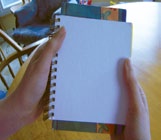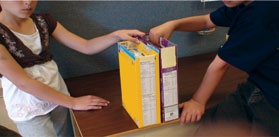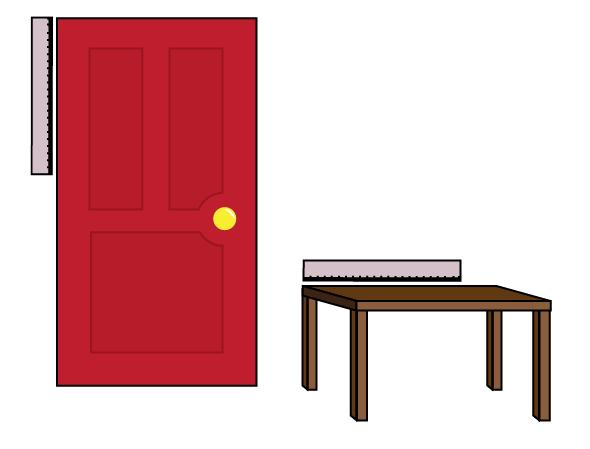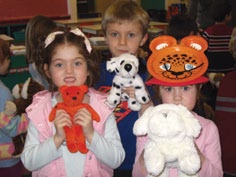E2.2 Compare several everyday objects and order them according to length, area, mass, and capacity.
Skill: Comparing and Ordering Objects
Comparing and ordering involves comparing two objects in terms of the same attribute. For example, to give an idea of the length of one's shoe, a student might compare the length of their shoe with the length of their friend's shoe and conclude, "My friend's shoe is bigger than mine." This strategy does not, strictly speaking, quantify the measurement of an attribute of an object; it simply establishes an order of size of that attribute by establishing that it is bigger or smaller than the same attribute of another known object. Note that we all use this strategy in many situations where we feel that it is not really necessary to quantify the measurement.
The measurement of an attribute of two objects can be made either by direct comparison or by indirect comparison.
From a very young age, children compare the measurement of an attribute of two objects by direct comparison (the height of the milk in two glasses, the thickness of one cookie compared to another, the distance of the throw of two different stones, etc.) and communicate the result descriptively, for example, "my glass has more milk than yours," "my cookie is thinner than his," "I can throw the small stone farther than the big stone."
Direct comparison can be done either by superimposing one object on another or by placing the two objects side by side or back to back.

Students stack notebooks to determine which one has the largest area.

Students place two boxes of cereal side by side and to see which is higher.

Two students stand back to back to determine who is taller.

Students find out which of the two objects has the greater mass by placing each object on a pan of a scale and observing which side it tilts.
When it is difficult or impossible to directly compare two objects on the basis of the same attribute, indirect comparisons can be made by using a third object. For example, it may be difficult to determine by direct comparison whether the door is longer or shorter than the table. However, using a third object, either a strip of paper, a string, or a tape measure, allows one to determine which of the two is longer. Since the table is approximately one meter in length, and the height of the door is twice the height of the tape measure, it can be inferred from this comparison that the door is twice the length of the table. The skill of comparing various attributes of objects by indirect comparison contributes to the development of the transitivity concept.

The ability to compare multiple objects is critical to developing a sense of measurement and relationships between measures. Students who have this skill will find it easier to make spontaneous references and estimates.
To compare and order, students often need to estimate. Estimating, comparing, and ordering skills enable students to sort objects according to measurable attributes. To do this, students need to perform several comparing and estimating activities not only according to observable attributes, but also according to less observable attributes such as mass and capacity.
To compare two or more objects by an attribute and order them, students must simultaneously identify objects as shorter and longer than others. These multiple comparisons develop reasoning that reflects the concept of transitivity.
Source: translated from Guide d’enseignement efficace des mathématiques, de la maternelle à la 3e année, Mesure, p. 87-90.
Specific terms can be used to describe and compare attributes:
- more, less, smaller, and larger are often used to describe only a general comparison of attributes, unless a particular attribute is included (for example, larger area, smaller capacity, larger mass).
- high, short, deep, wide, long, and thick are terms associated with length.
Examples of Object Comparison
Direct comparison of one object with another
- Length: align one object next to another
- Area: superimpose two faces
- Mass: weigh an object in each hand or use a pan balance
- Capacity: pour the contents of a container into another container
Indirect comparison of two objects using a third object
- Length: use a string to compare the length of two objects
- Area: use tiles to cover the surfaces of both objects
- Mass: use a pan balance to compare the masses of each object to a third object
- Capacity: pour the contents of the two containers into a third container, one at a time and compare the results
Source: The Ontario Curriculum. Mathematics, Grades 1-8 Ontario Ministry of Education, 2020.
During group learning situations and mathematical exchanges, students should use vocabulary related to unconventional and conventional attributes and units of measurement, compare objects using appropriate terminology, and describe measurement using correct and accurate terms.
For example, when comparing their stuffed animals, children can say:
- My bear is longer than yours.
- Mine is shorter than yours.
- Zoe's is the same height as Dylan's.

Teachers may need to guide students in the use of correct vocabulary.
For example, if a student says, "My piece of cake is bigger than yours," the teacher should prompt the student to clarify by asking if their piece of cake is longer, thicker or wider than their friend's.
Source: translated from Guide d’enseignement efficace des mathématiques, de la maternelle à la 3e année, Mesure, p. 27.
